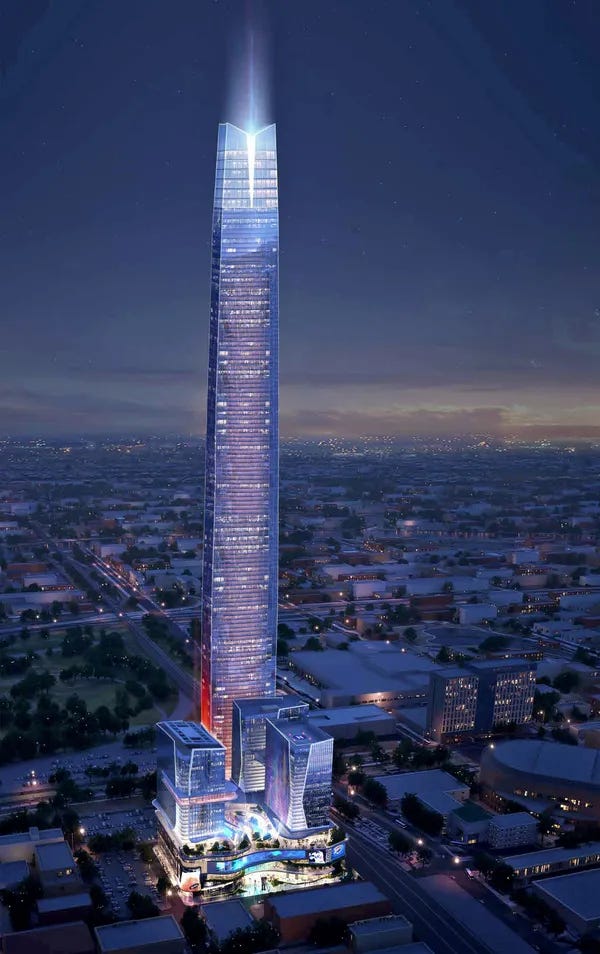4 Things This Week
Vision Pro, America's Tallest Skyscraper, Pocket Neighborhoods, and One More Thing
Welcome to the New Urban Order — where urbanists discuss the future of cities. I usually write an ideas-driven analysis each week, but wanted to test out a more news-driven post to see if people like it. I love writing this newsletter — please do upgrade if you love it too! We added 28 new subscribers last month — can we get to 30 in February?! ❤️ 🙏
Vision Pro is out there in the urban wild
Months after the Vision Pro was first announced, Apple’s mixed reality headset is now available for purchase. This means a lot of sightings of people using the Vision Pro in the wild, and lots of reviews of the technology on YouTube and TikTok. There’s even a name for the guys like the one pictured above: Vision Bros.
What will Vision Pro mean for cities? Last year I wrote about how I think living in regular reality while avoiding the pitfalls of a fully digital life will one day be the true privilege. I still stick by that stance.
As I watch these videos where you can basically block out the physical world with a digital window that will screen movies and games or whatever you want with Vision Pro, I feel like this isn’t “augmented” or “mixed” reality, this is subverted reality, diminished reality. We need to create a better set of terms to better reflect how these tech tools are changing the nature of reality.
Should we call it “individualized reality?” I really do worry that tools like Vision Pro, used en masse, will further drive divisions in society. Americans are increasingly divided about politics and pop culture, and I wonder if we end up spending more and more time in “individualized reality” if we simply won’t have a baseline of widely accepted reality that we all can work from.
Still there are more mundane questions to figure out in terms of what Vision Pro will mean for cities, like regulation and economic development. When the product was announced months ago, Greg Lindsay wrote about what Vision Pro could bring to cities:
There’s certainly an argument that augmented reality could be a boon for big cities, enriching and attracting foot traffic to iconic locations weakened by remote work. “I think we’ll see a growing digital divide between cities that embrace AR and those that thwart it,” said Jonathan Askin, director of the Brooklyn Law Incubator & Policy Clinic, who has studied the legal issues stemming from AR. “With governments suffering lost tax revenue from diminished retail and commercial real estate activity, cities and property owners could benefit from smart deployments of games, cultural experiences or even just new advertising opportunities.
I’m not optimistic about the Vision Pro world at all. Leave a note in the comments if you can see the bright side here!
Oklahoma City is maybe building the country’s tallest skyscraper
I’m amused by this attempt to build the tallest skyscraper in the country, potentially a top-10 tallest skyscraper in the world — in Oklahoma City, a part of the country that is better known for its low-slung architecture. Is this a brilliant marketing ploy for the building’s developer and for the city? Definitely. Is it going to get built? Probably not.
But what’s interesting here is that it would be purpose-built to focus on uses other than office space. Instead it would have 1,750 units of housing, a hotel, restaurants, and retail. This mixed-use concept is more in keeping with the mixed-use towers that are common in Asia.
Many years ago I wrote a piece for a Skidmore Owings & Merrill book about the future of the skyscraper. It was 2015, a time when it felt like people were newly obsessed by an aesthetic of the “urban pastoral” — nostalgia for Brooklyn brownstones and the main street aesthetic. Could this hankering for a skyscraper be a sign that we’re turning a corner?
In the piece I argue there’s room for the “form to be reborn” as something that feels enjoyable and even quirky, not just a mundane, boxy, tower:
The roof garden at the Lever House. The detailing at the top of the Chrysler Building. Even the Marina Bay Sands buildings in Singapore, with its infinity-edged pool spanning the roofs. These interventions suggests ways of reinventing a skyscraper so that it can be as enjoyable as a park — ways to build tall that may be seen to be as exciting as the newest side-street restaurant in some cozy urban pastoral neighborhood.
Despite the unlikely outcome of this skyscraper getting built, I love the ambition here and the possibility of a new era of mixed-use skyscrapers in the U.S. once interest rates go back down.
Do you know what a “pocket neighborhood” is?






